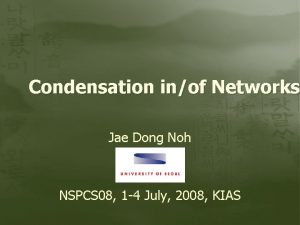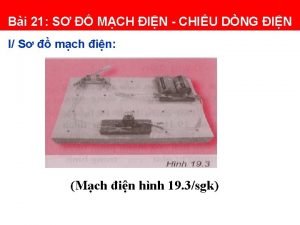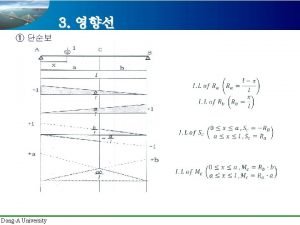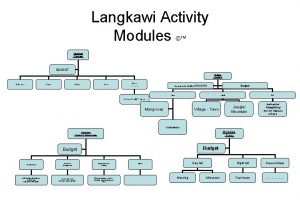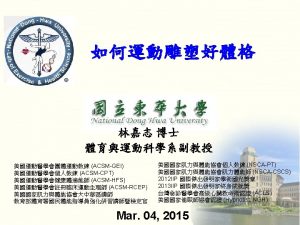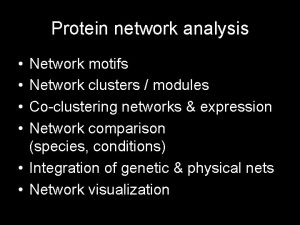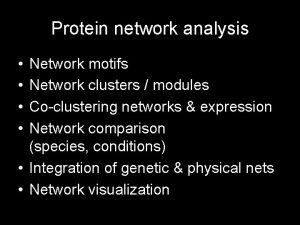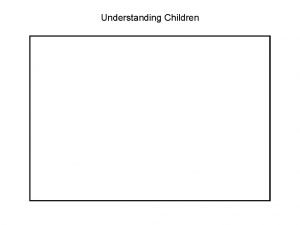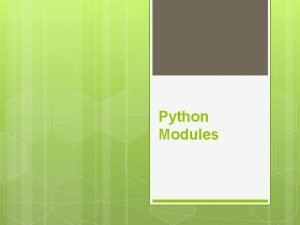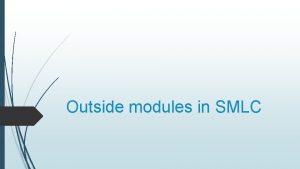Understanding Network Concepts in Modules Dong J Horvath











































- Slides: 43

Understanding Network Concepts in Modules Dong J, Horvath S (2007) BMC Systems Biology 2007, 1: 24

Content • Here we study network concepts in special types of networks, which we refer to as approximately factorizable networks. In these networks, the pairwise connection strength (adjacency) between 2 network nodes can be factored into node specific contributions, named node 'conformity'. • Scope: Our results apply to modules in gene coexpression networks and to special types of modules in protein-protein interaction networks

Background • Network concepts are also known as network statistics or network indices – Examples: connectivity (degree), clustering coefficient, topological overlap, etc • Network concepts underlie network language and systems biological modeling. • Dozens of potentially useful network concepts are known from graph theory. • Question: How are seemingly disparate network concepts related to each other?

Review of some fundamental network concepts

Connectivity • Gene connectivity = row sum of the adjacency matrix – For unweighted networks=number of direct neighbors – For weighted networks= sum of connection strengths to other nodes

Density • Density= mean adjacency • Highly related to mean connectivity

Centralization = 1 if the network has a star topology = 0 if all nodes have the same connectivity Centralization = 1 Centralization = 0 because it has a star topology because all nodes have the same connectivity of 2

Heterogeneity • Heterogeneity: coefficient of variation of the connectivity • Highly heterogeneous networks exhibit hubs

Clustering Coefficient Measures the cliquishness of a particular node « A node is cliquish if its neighbors know each other » This generalizes directly to weighted networks (Zhang and Horvath 2005) Clustering Coef of the black node = 0 Clustering Coef = 1

The topological overlap dissimilarity is used as input of hierarchical clustering • Generalized in Zhang and Horvath (2005) to the case of weighted networks • Generalized in Yip and Horvath (2007) to higher order interactions • Generalized in Li and Horvath (2006) to multiple nodes

Question: What do all of these fundamental network concepts have in common? Answer: They are tensor valued functions of the offdiagonal elements of the adjacency matrix A.

CHALLENGE Challenge: Find relationships between these and other seemingly disparate network concepts. • For general networks, this is a difficult problem. • But a solution exists for a special subclass of networks: approximately factorizable networks • Motivation: modules in larger networks are often approximately factorizable

Approximately factorizable networks and conformity

The conformity vector reduces the dimensionality of the adjacency matrix • Note that the (symmetric) adjacency matrix contains n*(n-1)/2 parameters a(i, j). • The conformity vector contains only n parameters CF(i) • Thus, by focusing on the conformity based adjacency matrix, we effectively reduce the dimensionality of the adjacency matrix. • This approximation is only valid if the network has high factorizability as defined on the next slide.

The higher F(A), the better ACF approximates A • The factorizability F(A) is normalized to take on values in the unit interval [0, 1]. Empirical observation: subnetworks comprised of module genes tend to have high factorizability F(A)>0. 8

Applications: modules in a) protein-protein networks b) gene co-expression networks

The Topological Overlap Matrix Can Be Considered as Adjacency Matrix • Important insight for protein-protein interaction (PPI) networks: • Since the matrix Top. Overlap[i, j] is symmetric and its entries lie in [0, 1], it satisfies our assumptions on an adjacency matrix. • Since the adjacency matrices of our PPI networks are very sparse, we replaced them by the corresponding topological overlap matrices. • Roughly speaking, the topological overlap matrix can be considered as a 'smoothed out' version of the adjacency matrix.

Hierarchical clustering dendrogram and module definition. Drosophila PPI network. The color-band below the dendrogram denotes the modules, which are defined as branches in the dendrogram. Of the 1371 proteins, 862 were clustered into 28 proper modules, and the remaining proteins are colored in grey; Recall that we used TOM instead of the original adjacency matrix as weighted network between the proteins

Hierarchical clustering dendrogram and module definition. Yeast PPI network



Observation 1 • Sub-networks comprised of module nodes tend to be approximately factorizable. • Specifically, they have high factorizability F(A)

We use both PPI and gene co-expression network data to show empirically that subnetworks comprised of module nodes are often approximately factorizable. CAVEATS • Approximate factorizability is a very stringent structural assumption that is not satisfied in general networks. • Modules in gene co-expression networks tend to be approximately factorizable if the corresponding expression profiles are highly correlated, • the situation is more complicated for modules in PPI networks: only after replacing the original adjacency matrix by a 'smoothed out' version (the topological overlap matrix), do we find that the resulting modules are approximately factorizable.

To reveal relationships between network concepts, we use a trick. • Strictly speaking it violates our assumption on an adjacency matrix since its diagonal elements are not 1. • It is very useful for defining approximate conformity based network concepts. • Approximately conformity based network concepts have several theoretical advantages as we detail below.

Network Concept Functions Abstract definition: tensor-valued function of a general n × n matrix M = [mij] a general matrix. Examples


Question: Find simple relationships between approximate CF based network concepts

Observation 1 Major advantage of approximate CFbased network concepts: they exhibit simple relationships Relationship between heterogeneity, density, and clustering coefficient

Observation 2 • Fundamental network concepts are approximately equal to their approximate CFbased analogs in approximately factorizable networks • Recall that fundamental network concepts are defined with respect to the adjacency matrix • Approximate CF-based network concepts are defined with respect to the conformity vector.

Drosophila PPI module networks: the relationship between fundamental network concepts Network. Concep (y-axis) and their approximate CF-based analogs Network. Concept. CF, app (x-axis).

Yeast PPI module networks: the relationship between fundamental network concepts Network. Concep (y-axis) and their approximate CF-based analogs Network. Concept. CF, app (x-axis).

Yeast gene co-expression module networks: the relationship between fundamental network concepts Network. Concept(A - I) (y-axis) and their approximate CF-based analogs Network. Concept. CF, app (x-axis).

Observation 3 Approximate relationships between network concepts in modules The topological overlap between two nodes is determined by the maximum of their respective connectivities and the heterogeneity.

Observation 3 (cont’d) • The mean clustering coefficient is determined by the density and the network heterogeneity in approximately factorizable networks. • Other examples involve the topological overlap • Thus, seemingly disparate network concepts satisfy simple and intuitive relationships in these special but biologically important types of networks.

Drosophila PPI module networks: the relationship between fundamental network concepts.

Yeast PPI module networks: the relationship between fundamental network concepts.

Yeast gene co-expression module networks: the relationship between fundamental network concepts.

Observation 4: network concepts are simple function of the connectivity in approximately factorizable networks where the last approximation assumes

Robustness to module definition • In our applications, we define modules as branches of an average linkage hierarchical clustering tree based which uses the topological overlap measure as input. • But our theoretical results are applicable to any approximately factorizable network. • We find that theoretical results are quite robust with respect to the underlying assumptions and are highly robust with respect to the module definition.

Summary • We study network concepts in special types of networks, which we refer to as approximately factorizable networks. • To provide a formalism for relating network concepts to each other, we define three types of network concepts: fundamental-, conformity-based-, and approximate conformity-based concepts. • The approximate conformity-based analogs of fundamental network concepts have several theoretical advantages. 1. they allow one to derive simple relationships between seemingly disparate networks concepts. For example, we derive simple relationships between the clustering coefficient, the heterogeneity, the density, the centralization, and the topological overlap. 2. Approximate conformity-based network concepts is that they allow one to show that fundamental network concepts can be approximated by simple functions of the connectivity in module networks.

Appendix

What is the conformity? This insight leads to an iterative algorithm for computing CF, see the next slide

Monotonic algorithm for computing the conformity
 Ring christmas bells ding dong
Ring christmas bells ding dong Rehatrainer
Rehatrainer Karl horvath
Karl horvath Horváth ákos elte
Horváth ákos elte Emily horvath md
Emily horvath md Tibor horvath
Tibor horvath Rite aid bryant
Rite aid bryant биопринтер
биопринтер Horváth gábor sze
Horváth gábor sze Types of printers
Types of printers Understanding core database concepts
Understanding core database concepts Pooh pooh theory of language
Pooh pooh theory of language Peter dong
Peter dong Dong nao jin
Dong nao jin Hệ thống thông tin logistics
Hệ thống thông tin logistics Dong quai nedir
Dong quai nedir Jae dong noh
Jae dong noh Sơ đồ mạch điện chiều dòng điện
Sơ đồ mạch điện chiều dòng điện Mishima yukio
Mishima yukio Changyu dong
Changyu dong Dong a university
Dong a university Hawmin
Hawmin Dong liu ustc
Dong liu ustc Disdoard
Disdoard Ugvr
Ugvr Lan dong
Lan dong Salitang katutubo halimbawa
Salitang katutubo halimbawa Dong liu ustc
Dong liu ustc Yuxiao dong
Yuxiao dong Cây mọc lên từ hạt
Cây mọc lên từ hạt Dong pei li
Dong pei li Xiaolong dong
Xiaolong dong The le family was sleeping when mailman
The le family was sleeping when mailman We mean business
We mean business Dong liu ustc
Dong liu ustc Zan fei
Zan fei Dong sun-hwa
Dong sun-hwa Luna_xuany
Luna_xuany Có mấy loại dòng biển
Có mấy loại dòng biển Hoa có cả nhị và nhụy
Hoa có cả nhị và nhụy Ziqian dong
Ziqian dong Bài 33 dòng điện xoay chiều
Bài 33 dòng điện xoay chiều Tinka design
Tinka design Organization model in network management
Organization model in network management
















